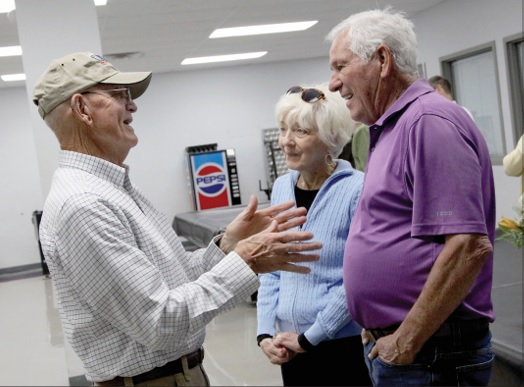RECOVERVILLE SERIES: Downburst delivered wind damage
BY KYLE TROUTMAN ktroutman@cassville-democrat.com
The National Weather Service and Barry County Office of Emergency Management have determined a downburst over Cassville to be the cause of an estimated $5 million in infrastructure damage and the county to pursuing federal disaster declaration funds for individuals.
According to a National Weather Service (NWS) survey, while no tornadic rotation was observed on radar, a wide swath of damaging wind gusts at least 70-80 miles per hour swept through Wheaton to the Cassville, Shell Knob and Eagle Rock areas.
Steve Runnels, warning coordinator meteorologist for the NWS in Springfield, said as the storm approached, it had shown some signs of rotation, but that faded as it moved into the county.
“There was lots of instability and wind shear, which we anticipated in a severe thunderstorm,” Runnels said. “That can include damaging winds or tornadoes. Looking at the reflectivity and velocities, we make the determination if there is a threat to life or property present and issue a warning, and that was issued because of the wind and hail.”
The warning came about 20 minutes before the storm — moving east at 65 miles per hour — left significant damage in Exeter, Cassville, Shell Knob and Eagle Rock.
“The thunderstorm warning was issued for a supercell that had a rotational updraft and could have produced a tornado,” Runnels said. “There was indication of rotation as it moved toward Cassville, [but as it got closer], it began showing less of a tornado threat and more of a hail and high winds threat. What happened then was a phenomenon called a downburst, which hit the ground and burst outward through Cassville to Shell Knob.”
A downburst occurs when a column of significantly precipitation- cooled air subsides through the storm to the ground, bursting outward in all directions. The effect is similar to how water comes out of a faucet and hits the sink.
David Compton, director of the Barry County Office of Emergency Management (OEM), said that occurred directly over Cassville.
“As it rolled in, I’d had my eyes on it for several hours,” he said. “The system came from Oklahoma moving east. It had tornado signatures over Oklahoma, and there were two hook echoes in Arkansas. You expect to see tornadoes on the southwest corner of those storms, and Barry County was in the northern part of the storm. [As it came into the area], on one radar scan we saw high winds, then on the next scan, we saw the speed of the wind increase greatly into a macroburst over the top of Cassville.”
A macroburst is a downburst with horizontal dimensions larger than 2.5 miles, which Runnels said was clear after his survey.
“Looking at the damage after, I saw a lot of trees downed west-to-east or northwest- to-southeast, which is an indicator of winds of 70-80 miles per hour,” he said. “Some roofs and siding were damaged, but there was not very much widespread structure damage. It was mostly to trees.
“The uniform direction of the trees falling to the east provides evidence of straightline winds from the downburst versus cyclonic winds from a tornado. Tornadoes are generally compact, with a damage path 1/4 to 1/2 a mile. With this storm, the damage path increasingly became wider. It was a 5-mile path at the end in Shell Knob.”
Tornadoes, on the other hand, send trees and damage in multiple directions.
“In a tornado, you’d see areas of trees where some are blown over to the east, others to the north, some to the west and some to the south,” Runnels said. “It’s that rotational pattern over the overall storm path that is indicative of a tornado. The trees were largely in the same direction, and I did not see any swirl patterns in grass. Sometimes, a tree may look like it twisted or fell in a certain direction, but an individual tree or limb cannot provide indication of wind direction because each tree is subject to force in different spots.”
Though the NWS and OEM agree there was no confirmed tornado, the scope of the damage has left many residents asking why there was no warning.
“We were getting opposing winds, but no wrapping,” Compton said. “I called the National Weather Service, and they said there was mid-level rotation, but nothing that extended to lower levels, and our spotters saw similar evidence.
“Our threshold for sounding the sirens is a tornado warning by the NWS, a trained weather spotter seeing rotation near or on the ground, or sustained winds of 75 miles per hour. Had we seen 75-mile-perhour winds in McDonald County as it crossed into Barry, we would have sounded them, but we had 60-mile-per-hour sustained winds. When it became apparent gusts were in excess of 80-85 miles per hour, it was right over us.”
According to the enhanced Fujita scale, an EF-0 tornado produces 3-second wind gusts of 65-85 miles per hour, meaning the storm produced tornado-level wind at the time of the downburst.
The location of the storm at that time forced Compton to use restraint in issuing a siren order.
“Our decision was if we sound the sirens, we’d be sending people into a dangerous situation,” Compton said. “The safest thing to do at that point, with the wind and size of hail, was for people to stay where they were at.
“We also don’t have any sirens east of Cassville. We’re hoping to get some in Roaring River soon, hopefully this summer.”
Siren decisions come completely at the local level. Runnels said the NWS does not have the authority to direct any entity to sound sirens.
However, he added when the NWS issues warnings to consider them serious weather events with the potential to harm.
“When you hear of a tornado warning, flood warning, or in this case a severe thunderstorm warning, those are issued when a storm is a life-threatening event (with wind speed at least 70 miles per hour) if you are outside,” he said. “As we saw with all the downed trees, a severe thunderstorm can be a life-threatening event.”
During such an event, the NWS typically has two or three meteorologists working, and more may be called in to help. The NWS and OEM both utilize the Storm Prediction Center in Norman, Okla., radar and trained weather spotters to make warning determinations.
“We try to message to the public what we know when we know it, and what to expect,” Runnels said.
The OEM is also in contact with all local fire and police chiefs, as well as other emergency responders.
As the night drew to a close and the sun came up on May 26, Compton said debris reports came pouring in.
“Debris reports slowly came in overnight, and they really ramped up when daylight hit,” he said. “County, state and federal assessment teams have met to evaluate individual assistance. We collected a lot of information, and the Small Business Administration was here assessing businesses. The goal is to assess 10-20% of homes and structures damaged, and that is enough to make a declaration.
“We also add an impact statement, which is not about the individual losses, but the fact the entire community had so much damage the extent of the recovery will be very difficult.”
Individual assistance is subjective and based on impact, awarded by President Joe Biden.
“We feel we’ve made a strong case, but it’s up to the President,” Compton said. “We feel we’ve demonstrated the need very well.”
If granted, individual assistance would open up FEMA funding for people who sustained damage to their homes or were displaced by the storm.
The county has also met the threshold for public assistance from FEMA, with millions of dollars in damage estimated.
“On public assistance, the threshold is $158,000 in damage to public infrastructure, which is everything from county roads to bridges and debris removal to public utilities,” Compton said. “We have to validate about $30,000, and we went out in one day and validated just a small percentage of the damage, maybe 30%, and came up with $975,000. We estimate at least $5 million in total damage, and that’s on the low end.”
Awarding of public assistance will help entities managing public property recoup some financial costs of recovery.
Individuals still in need of assistance should contact the Ozark Area Community Action Corporation’s Barry County Neighborhood Center, located at 10826 Farm Road 2172, by calling 417-847-2140.
“The Unmet Needs Committee has been around for 20 years and has leaned on OACAC to help,” Compton said. “It’s been very successful, and Kimberly Healy, who recently replaced Gail Reed, has come out of the gate strong. She’s six months on the job and handling her first big disaster. People can make donations to OACAC for disaster relief, and 100% of those funds will go to those in need because of the storm.”
One area of need, Compton anticipates, will be repairing vehicles damaged by hail.
“Autoglass will be an issue because of resources here, so we will have a need for money or donations of services to fix autoglass,” he said.
Compton also said those with SNAP benefits who lost their food as a result of the storm should call their Division of Family Services rep to get their card reloaded for the amount lost.




